Rovaniemi: Finland’s winter wonderland on Arctic Circle
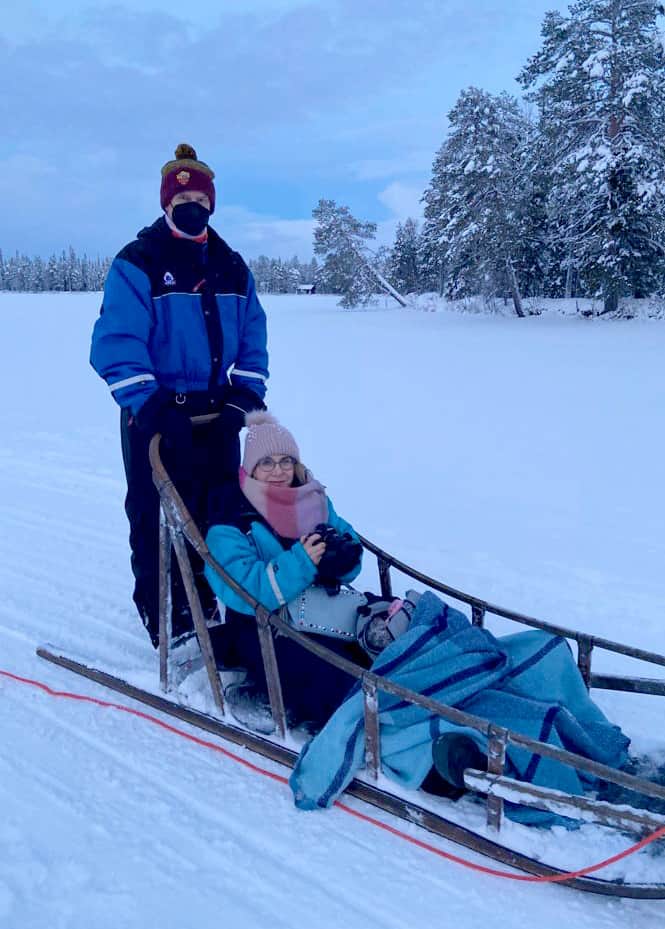
(This is the first of a three-part blog on Finland. Today: Rovaniemi.)
ROVANIEMI, Finland – I never believed in Santa Claus but I have an idea how beautiful his reindeer sleigh ride looked every Christmas Eve.
Saturday I stood on the back of a dogsled, being hauled across a vast, frozen lake covered in snow 10 kilometers (six miles) north of the Arctic Circle. Five Siberian huskies pulled me and my girlfriend, Marina, laying down in the long sled feeling warm despite the 27-degree weather, through 10 kilometers of Lapland wilderness.
As we turned a corner, hovering over a forest of snow-covered, potentially perfect Christmas trees, hung the moon. It looked almost comically big, like a giant wheel of parmesan cheese over a snow-white countertop. No Finnish artist – not even a camera – could have captured it better than Mother Nature did at that moment.
Forget Santa’s presents. I got my Christmas gift right then.

Rovaniemi is planet Earth’s winter wonderland. It markets itself as Santa Claus’ hometown, and its Santa’s Village makes you wonder when Santa became such a capitalistic cus. Christmas trees and snowmen are everywhere. So are 200-euro sweaters, Santa keychains and 26-euro sauteed reindeer.
But Rovaniemi isn’t just for kids and rich, exasperated parents making their children’s dreams come true. It’s also for adults, for adventurers and people like me who want to see the polar world in its most beautiful state before global warming changes it all.
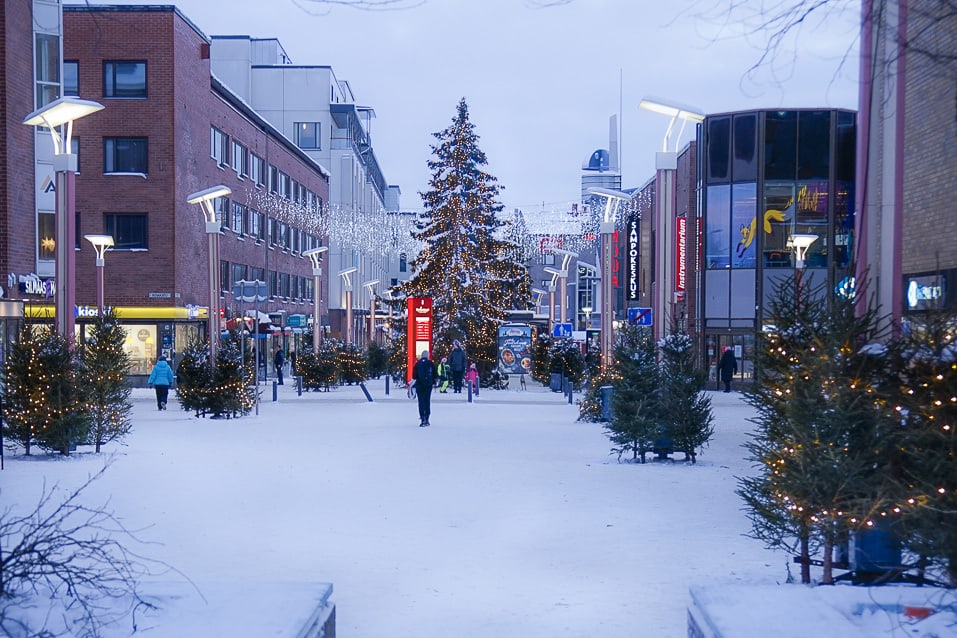
Marina and I took a reindeer sleigh ride through a forest, saw the Northern Lights and, yes, went dog sledding through a magical landscape that warmed us more than our three layers of thermal clothes did. In between we took saunas in our hotel room, ate moose and Arctic char and had long strolls in a quaint, snow-covered town covered in Christmas lights.
It’s easy flying here, but in this time of Covid, logistically it really felt like a trek to the North Pole. We flew from our home in Rome through Munich to Helsinki. After two nights in that beautiful capital, we took a 75-minute flight north to Rovaniemi, smack dab on the 66th parallel: the Arctic Circle.
However, the Omicron virus is surging in Italy and Finland. Travel restrictions are tighter, hopelessly confusing and expensive, adding a lot more stress to our trip than five Siberian huskies running across a frozen lake ever could. (More on travel frustrations in my epic rant next week.)
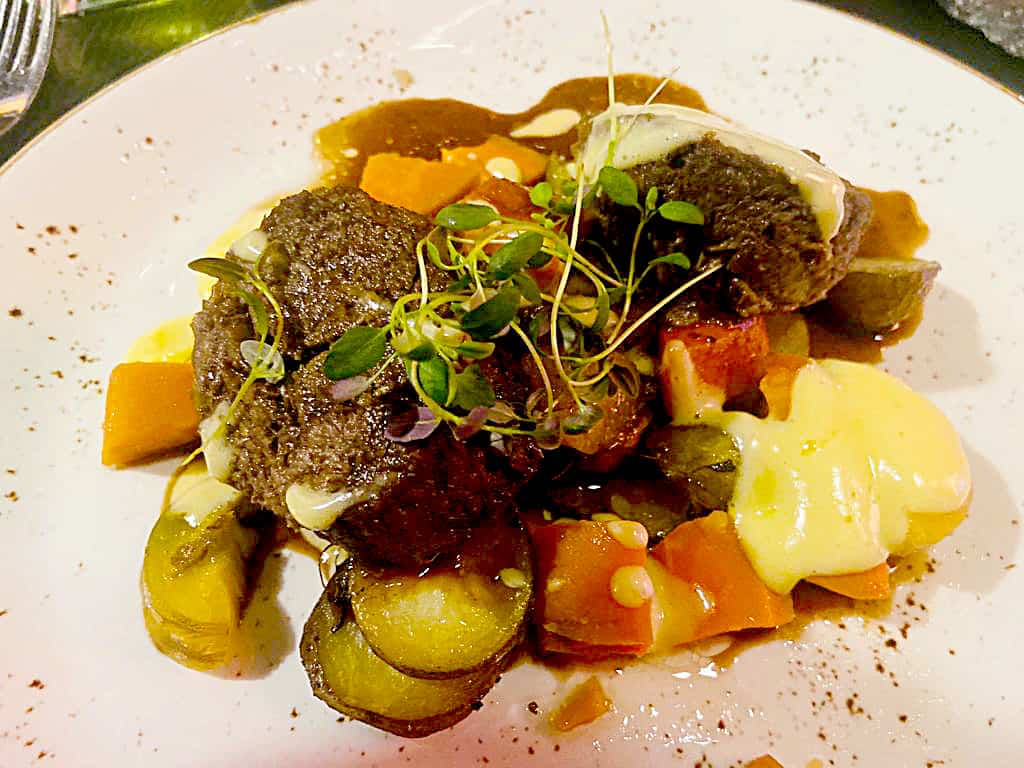
You need three things to visit Rovaniemi around Christmas: One, an ability to handle cold weather. It was minus-15 Celsius (5 Fahrenheit) when we waited outside 45 minutes to get Covid tested Monday morning. Two, you must not get depressed about eternal darkness. The sun rose at 11 a.m. and set at 1:30 p.m. Three, you need money. Finland is not budget travel. Our 15-minute reindeer sleigh ride was 58 euros for two people. Our modest hotel room was 158 euros a night. Our Covid test was 99 %$@#! euros each. (More on this unabashed sodomy next week.)
The darkness throws people’s equilibrium into a blender. You never know what time it is. We’d wake, have breakfast, walk into the town center and it would still be as black as the inside of a cave. When we saw the moon during dogsledding?
It was 2:15 in the afternoon.
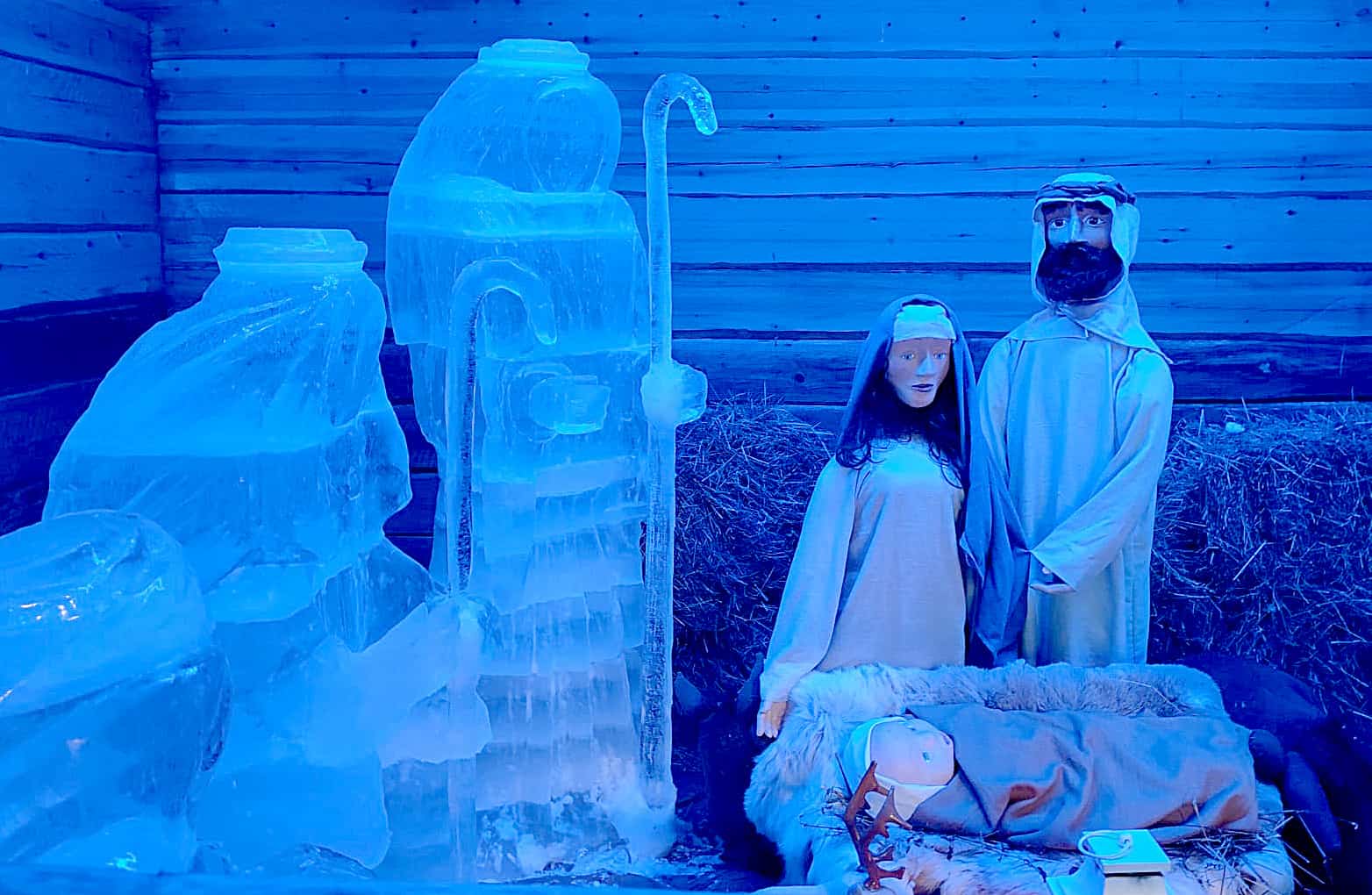
Even the Finns struggle with it. Despite earning the label of World’s Happiest Country the last four years by the United Nations Sustainable Development Solutions Network, Finland has the highest suicide rate (13 of 100,000 people) of any Nordic country, where suicide is a common social issue. Finland has halved its suicide rate the last 20 years thanks to a national campaign but the dark winters are often cited as a cause.
“When it’s dark and something goes wrong, your mind goes dark,” said Pele Koivistoinen as he served me Karhu beers at Hattrick Sports Bar downtown.
I loved it. I love cold weather. I’d rather be too cold than too hot. You don’t sweat. You don’t get thirsty. You don’t tire. Plus, the sauna feels better. I also love nights, especially in the snow. It’s so clean. Snow under the lights has a romantic, artsy effect whether you’re in Finland or Nebraska. I lived in Denver for 23 years. I was back in my element.
But I never saw a reindeer, mush dogs or photographed Northern Lights in Denver.
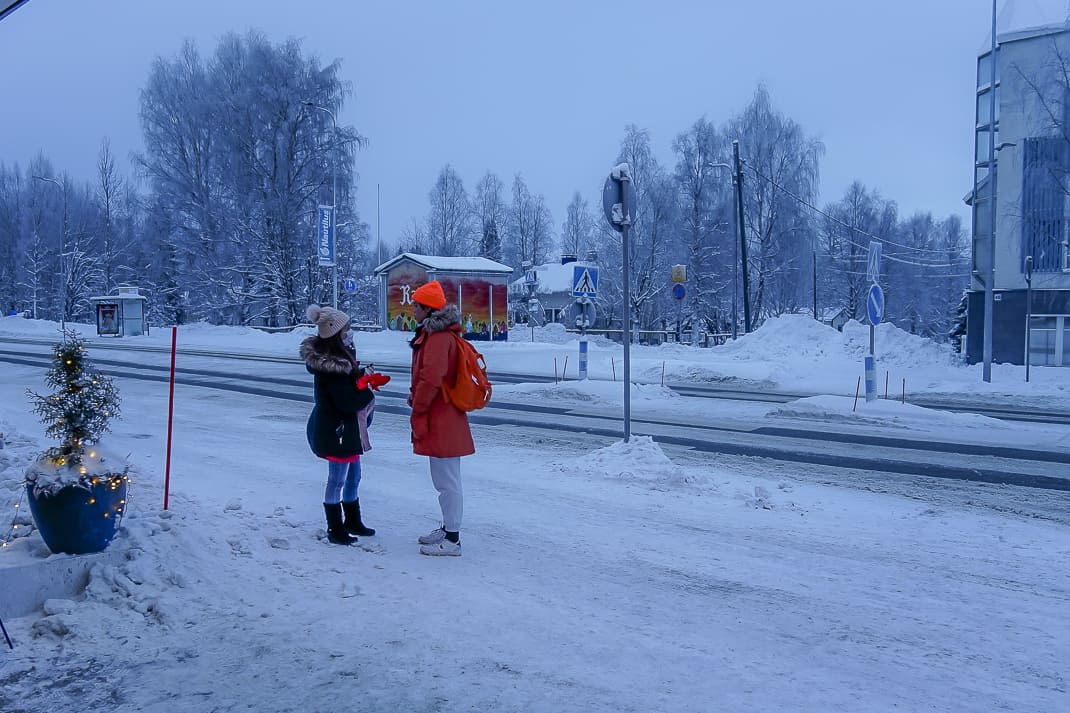
Rovaniemi, located 810 kilometers north of Helsinki and 200 from the Russian border, has more reindeer than its 63,000 people. In fact, after the Germans destroyed it in World War II, Finnish architect Avvar Aalto designed the city shaped like a reindeer’s head. From the air, if the three rivers running through it are antlers, you can envision it, although a Reindeer Tear (shot of Finland’s Koskenkorva vodka with three lingonberries) might help your imagination.
Fortunately, there’s a lot more to do around here than drink. To wit:
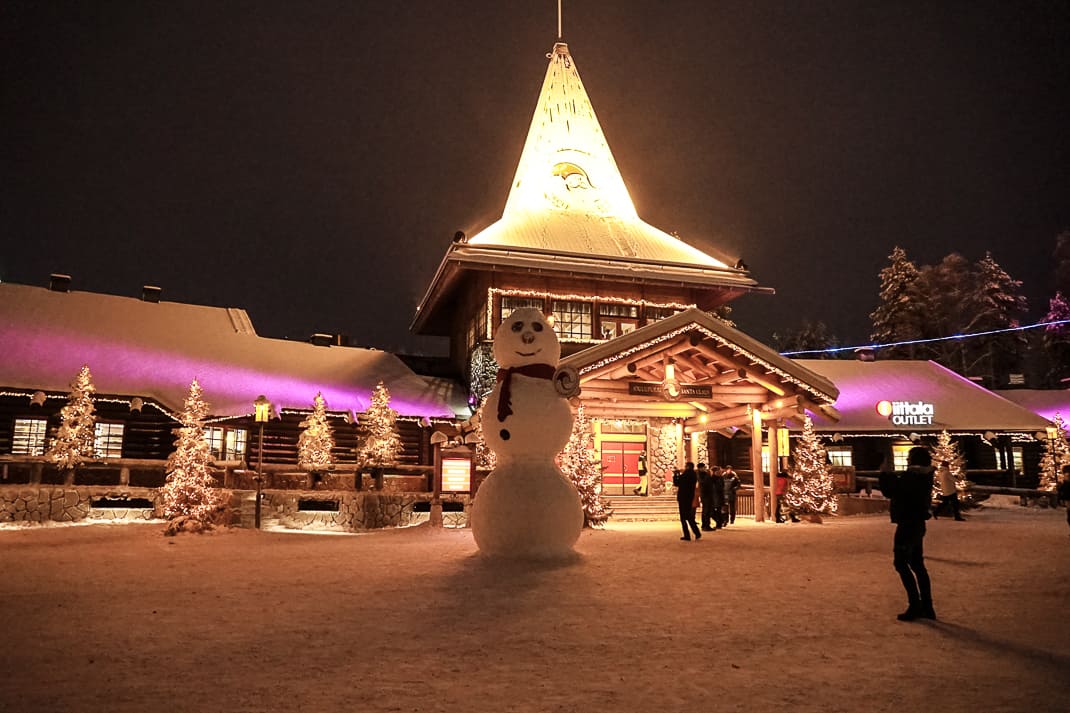
Santa’s Village
Inspired by the Nordic myth that Santa is from Lapland, the city designed Santa’s Village in 1985. Since 2008 it has ranked as the second-best travel adventure in Finland behind Wilderness Week. We took a city bus five kilometers northeast of town where we walked through the main office and stepped across the white line onto the north side of the Arctic Circle.
Emerging from the back end looks like something out of a Currier and Ives painting. A 15-foot snowman stood smiling not far from a 100-foot Christmas tree with smaller decorated trees everywhere else you look. Children rode sleds around the grounds. “Silent Night” played over the loudspeaker.
Behind the snowman is a big, brightly lit A-framed building where Santa allegedly has his office. Oh, you can find Santa there. But in the down season I think he’s a car mechanic in Helsinki.
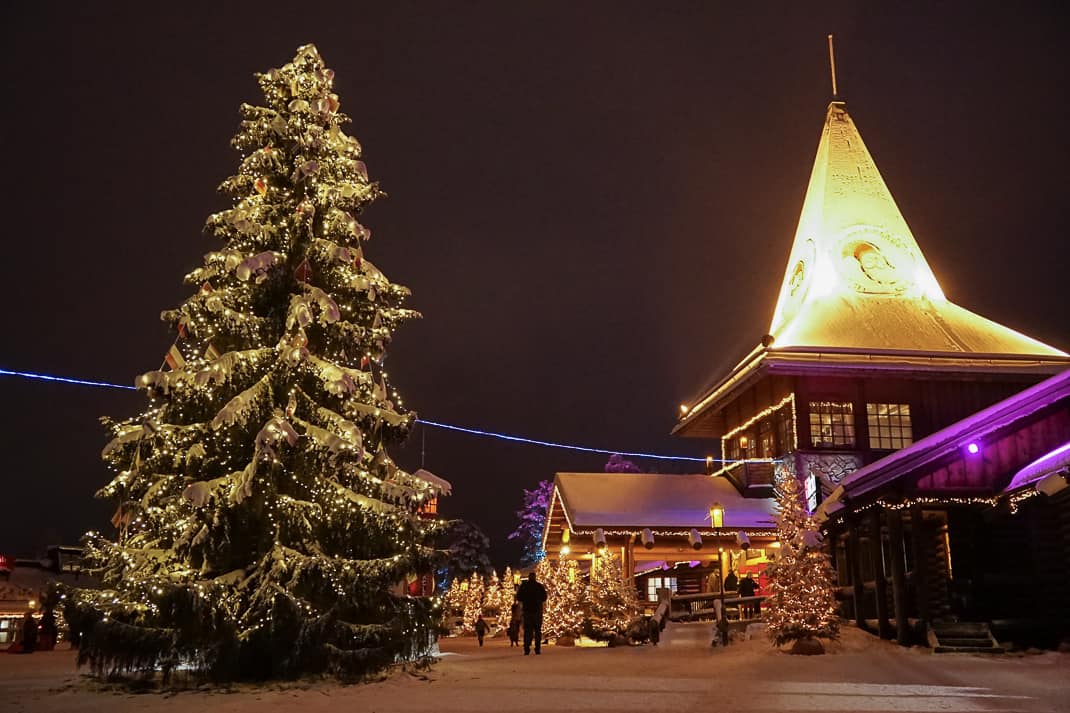
Seriously, Santa’s Village does get letters to Santa. Economic Times reported that in the 36 years of existence, Santa’s Village has received 15 million letters from 200 countries. In December it gets about 30,000 a day. For visitors, you can go to the village post office and send a card complete with an Arctic Circle postmark.
Yes, the image of the Currier and Ives painting mesmerized me into coming here. I wanted a sleigh ride through town, sparking images of White Christmases I dreamed about growing up in Oregon. In Santa’s Village, you can do that – with reindeer.
I paid the larcenous fee of 58 euros and squeezed into the narrow, cozy sled with Marina under a comfy reindeer fur blanket. The romance took a hit when Marina, trying to take pictures for me, said, “Move your arm! I can’t move!” It also didn’t help the mood when the reindeer started walking and took a major dump right in front of our sled.
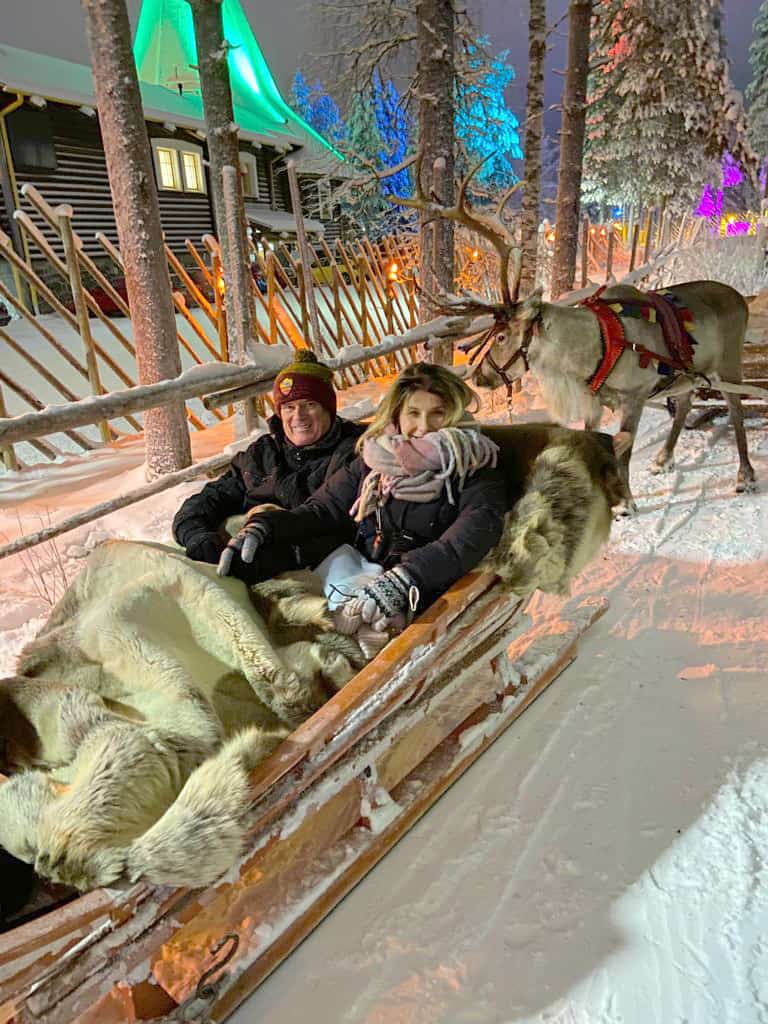
However, Christmas romance soon enveloped us as our guide led the reindeer into the deep forest. Reindeer are revered in Lapland, especially by the Sami people in Northern Finland where they use everything from the stomach for a cooking pot to its milk for yogurt and cheese to its meat which they smoke, fry, bake and boil. The Sami eat every part of the reindeer – except the tip of the tongue.
The Sami believe eating it will make you lie.
But global warming has hurt the reindeer population. Winter rains freeze into the ice, keeping reindeer from eating the lichens on the ground. Reindeer are starving. According to The New York Times, the reindeer population has been cut in half to 2.3 million in 2019.
Our reindeer, named Jermu, was a kindly sort with his two foot-long horns and a festive collar. Jermu loves affection and petting him was like rubbing your hands through a lush carpet freshly cleaned. He and the other 100 reindeer are pampered here. Before and after every ride, they eat three kilograms of moss, their food of choice.
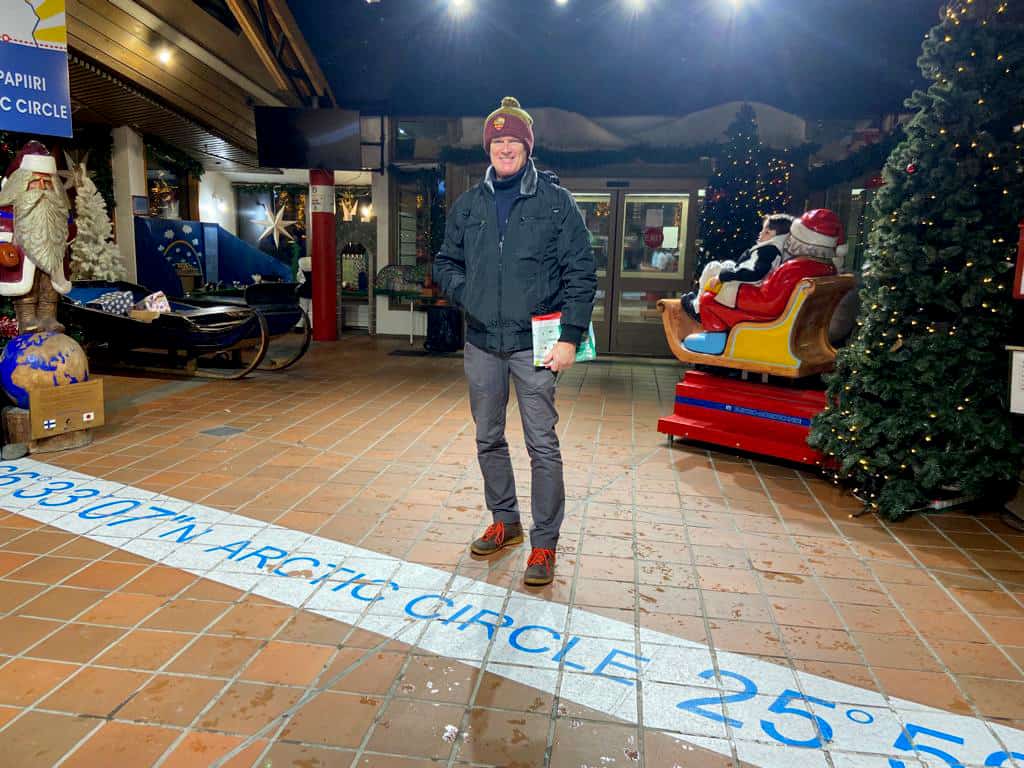
We turned away from the village and soon the sounds of laughing children and “Little Drummer Boy” were replaced by the slushing of snow under the sled. We went under towering snow-covered trees, with the lights of the village flickering in the background. Marina and I felt oh, so warm under the blanket despite the 23-degree (F) temperature.
Soon we passed a field of large, round pods. These are the igloo huts which really aren’t made of ice. They’re made of wood and have glass roofs where you can see the stars and occasional Northern Lights. And these can be yours for only 613 euros a night.
We only went 1,000 meters but the memory will last 1,000 Christmases.
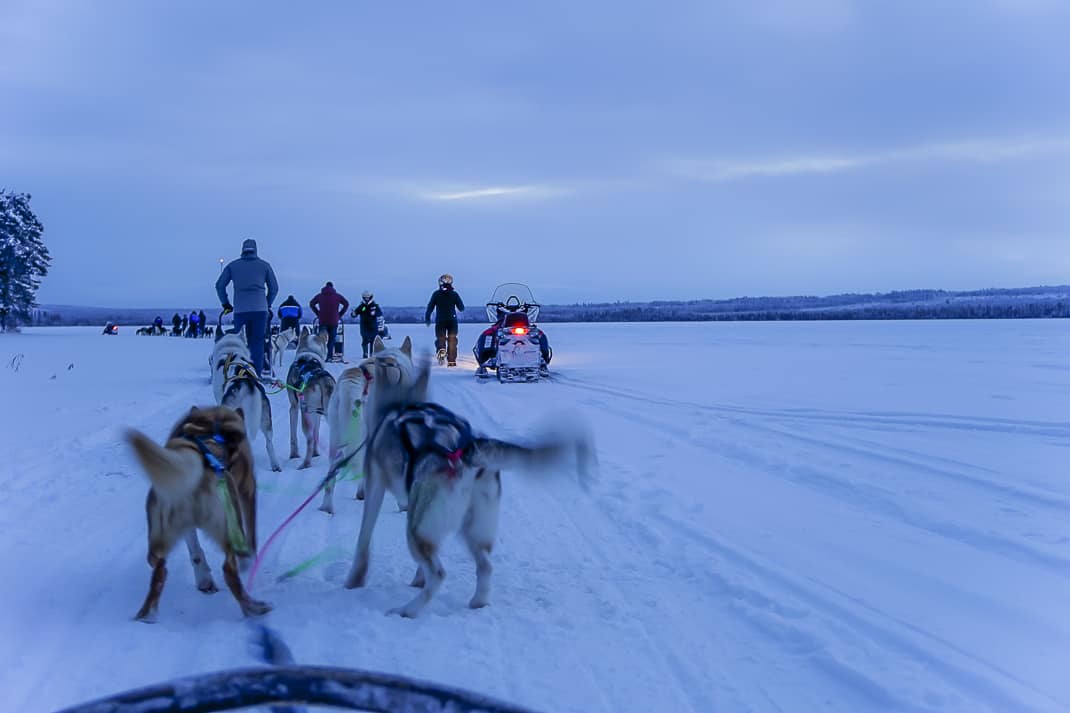
Dog sledding
The Bearhill Husky van was packed with people from around the world. Many took advantage of Finland’s inexcusable, lackadaisical mask rules which are encouraged but not enforced. Marina grew increasingly worried and even told a Russian across the aisle to put on a mask.
It was all forgotten when the van dropped us off in the middle of a deep forest 10 kilometers north of Rovaniemi. We all herded into a big cabin where we changed into Arctic jumpsuits. It wasn’t that cold by Finnish standards. It was only about 5 degrees Celsius (27 Fahrenheit). But the dogs run at about 15 kilometers an hour (9 mph), creating a wind chill that above the Arctic Circle feels like daggers in your face.
We received instructions on dog sledding, in English, from Hanne Mare Valtonen, the Finnish guide. It’s simpler than riding a bike. I was told to stand on the two rudders at the back of the sled and hold on to the horizontal bar in front of me.
“Never, ever, Ever, EVERRRRR, under any circumstances, never, EVER let go of the bar,” said Hanne, demonstrating how you can fall and still hang on.
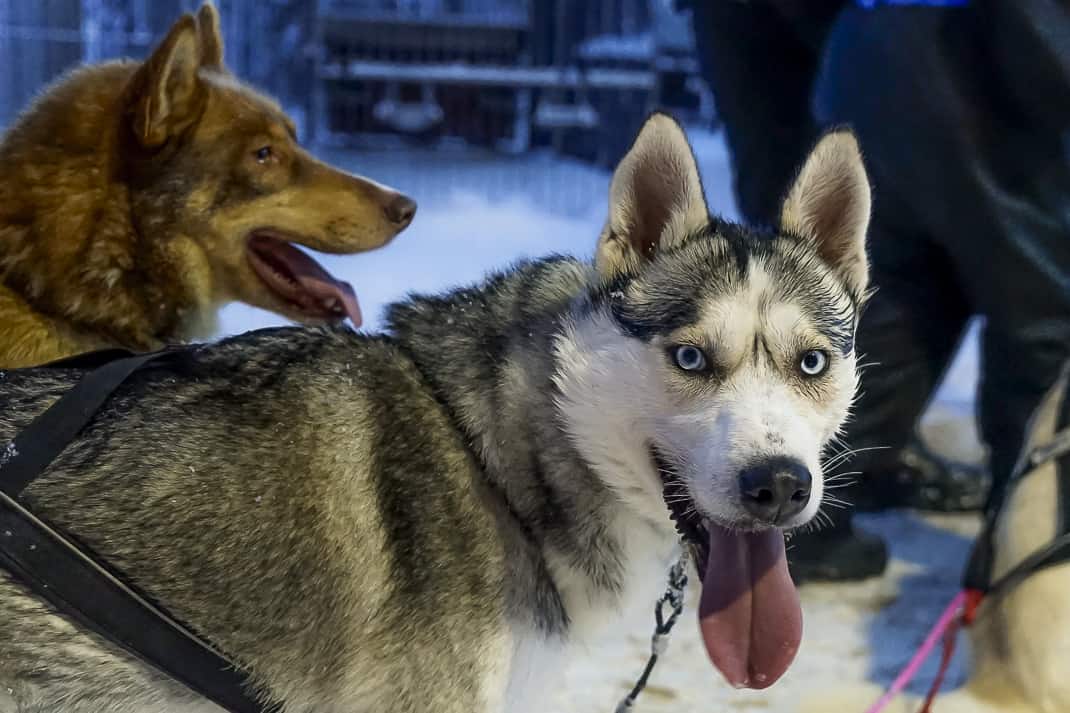
Marina? She just laid down in the sled under a blanket.
There’s a semicircular steel bar with long, sharp teeth near my feet. That’s the brake. I was to press down on it with one foot to go slower and stand on it to stop. Ride it lightly at the start of the trip as the huskies like to tear out of the starting gate as if they’re running toward steak bits and haven’t eaten in a week.
And the huskies were ready to fly like Santa’s reindeer. (Check out the video on my Dog-Eared Passport Youtube Channel.)
As the handlers untangled their ropes attached to the sled and unlocked the ties around the trees, the dogs started furiously barking. It sounded like a thousand watch dogs getting invaded by burglars.
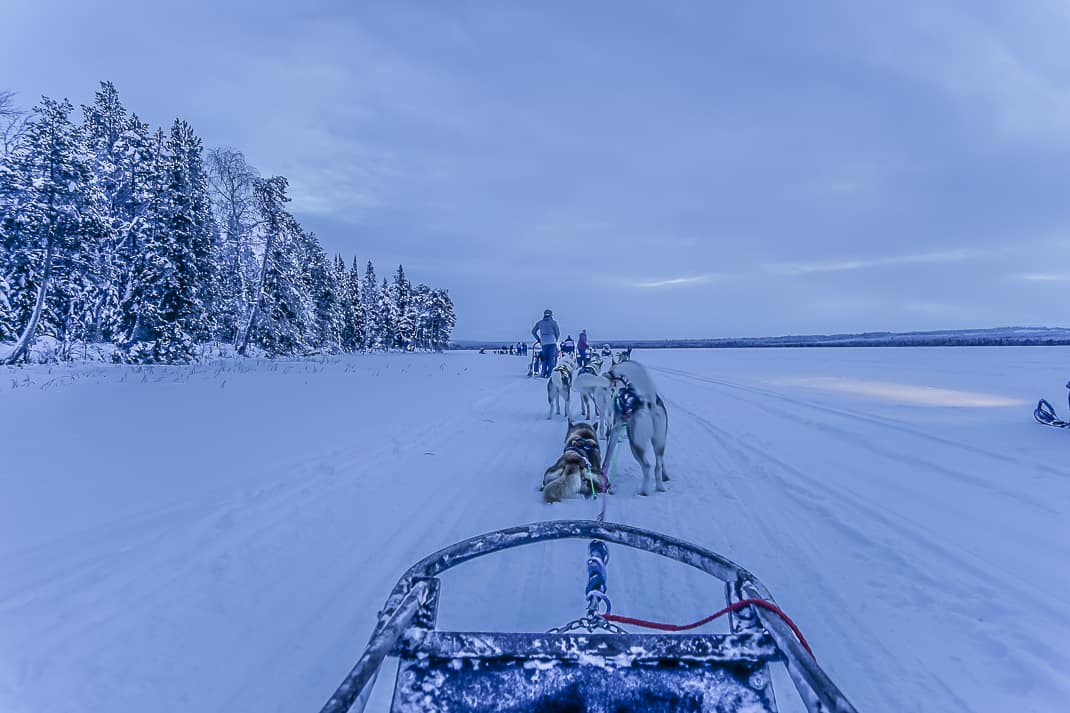
It’s amazing how strong five Siberian huskies are. Marina isn’t very big but I weigh 200 pounds (90 kilos) and the dogs flew out into the woods so fast Marina immediately screamed for me to slow down.
What’s underrated about dog sledding isn’t the huskies’ raw power. It’s the beauty of the scenery. We wound our way along narrow paths through thick forests of perfectly shaped birch, pine and spruce trees. We were 30 minutes from the nearest house. The only sound we heard was the smooth, wet motion of the wooden sled through the snow.
Sometimes when we slowed or stopped, the huskies got tangled up. One of the guides tagging along would come over and straighten the ropes. I’d yell “Andiamo! (Let’s go!) and they’d take off again.
After about 20 minutes of scraping past tree branches, we hit a massive, empty expanse. Lake Viiksjarvi was frozen and covered in snow. It was wide-open spaces and the 10 dog teams opened the throttle. The dogs switched gears and we flew over the open plain.
Then came the highlight of our five days in Finland.
We turned a corner and there above the trees to our right hung that giant moon. Marina openly gasped. I almost let go of the sled. It looked like something out of a science fiction movie when atmospheric pressure moved the moon as close to us as Stockholm. It was mesmerizing.
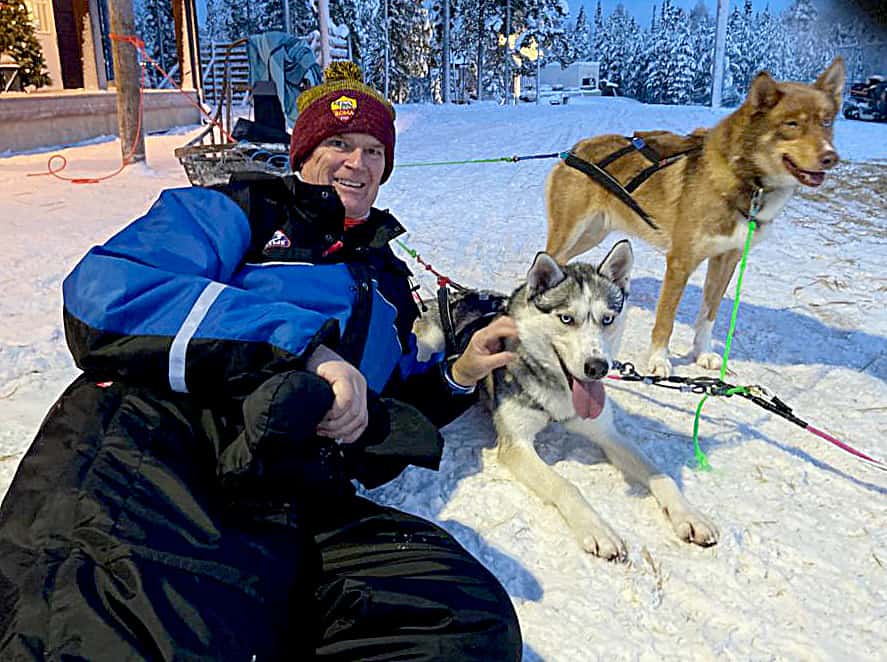
We continued the loop back to the dogs’ pen. We covered 10 kilometers (six miles) in less than an hour but it felt like we had already bonded with the dogs. We all spent about 15 minutes with them, hugging them, petting them, feeling their velvety soft, warm fur against our bare hands. They panted lightly, closing their eyes in bliss when we patted their heads.
For an animal lover, dog sledding is the ultimate adventure.
Afterward we gathered in a warm hut where we drank hot fruit punch and ate ginger cookies. I talked to Hanne about dogsledding and huskies and she blew out any PETA argument about animal cruelty.
They run 30-40 kilometers a day but that makes them happy, not oppressed.
“It’s their strong instinct to run,” she said. “They really enjoy it. Of course, we make sure they get enough rest, get enough high-quality food so they can keep going.”
American sports fans all know about the Iditarod, the iconic dogsled race that covers 938 miles in Alaska. The Nordic countries also have one. The Finnmarkslopet covers 1,200 kilometers (700 miles) over eight days through Sweden and Finland. Each of the 160 sleds has 14-16 dogs.
“The musher really needs to hold on and not let go of the team in the middle of nowhere,” she said. “That’s an amazing amount of dog power.”

Northern Lights
There is cold and then there is Northern Finland-in-the middle-of-the-night-in-December cold. We again were whisked 30 minutes north of Rovaniemi and everyone but me changed into Arctic suits for an extended period in the elements. I felt fine.
A team of small vans took us down a dark road to a darker clearing. It was 10 p.m. and the Finnish forest was so black, against the thick snow it looked like we walked into a giant black-and-white photograph.
It was minus-8 Celsius (19 Fahrenheit),
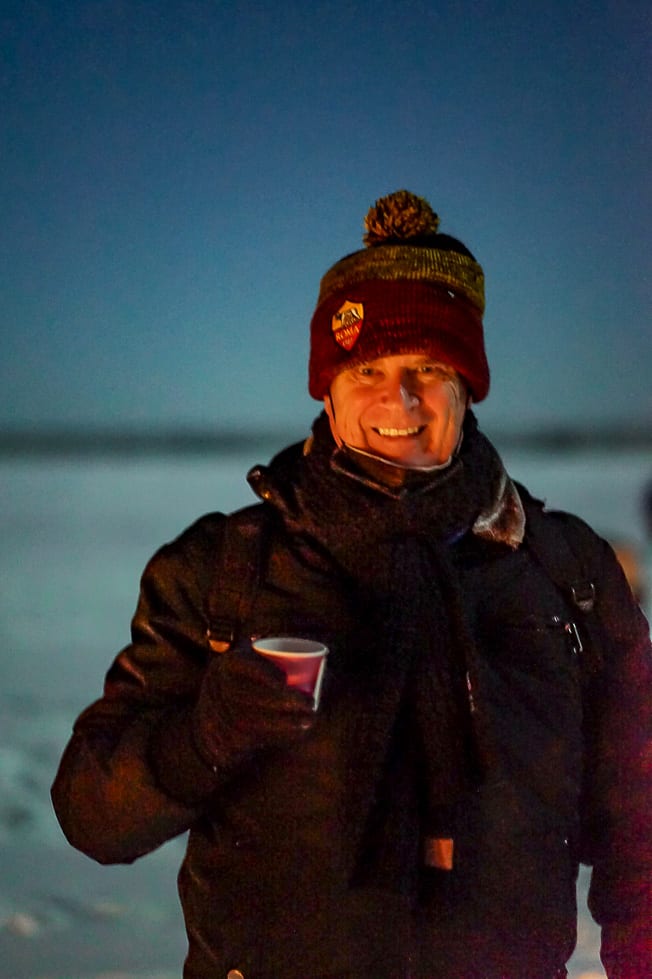
The guides said the cloud cover and full moon weren’t ideal. The best conditions are a cloudless, cold night but that week they had seen the Northern Lights every night. All I saw was blackness.
Suddenly a guide pointed up and said, “There! Look!”
I did. I saw little. Oh, maybe a slight streak in the sky. Discouraged, I pointed my cell camera and – HOLY HELL! – through my iPhone 11s viewfinder, that slight streak was a giant green stripe painted across the heavens. It looked like a party streamer. The 11 p.m. sky was curiously blue.
Then I heard a collective “OOOOOOH!” The crowd of about 30 people pointed their cameras in the other direction. Here was another, a vertical green streak starting from another galaxy and hitting the forests across from us.
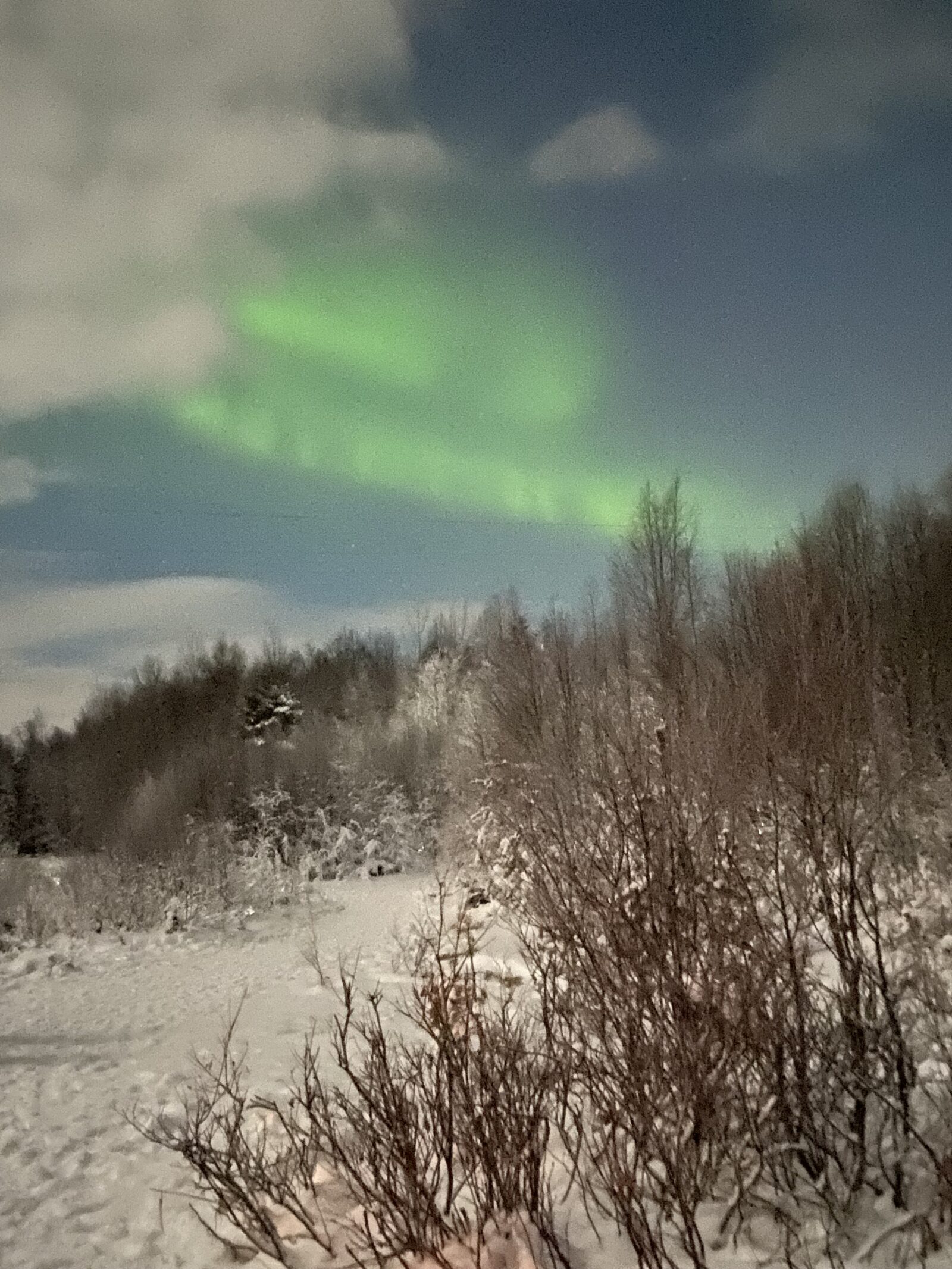
Then came another. Then another. Then another. Green streaks were everywhere. It was like Mother Nature got drunk and found a paint brush and some green paint.
Northern Lights, or Auroras as they’re often called, are hard to explain. The way I understand them is solar winds cause them. They disrupt the magnetosphere with particles such as electrons and protons which rain down on the upper atmosphere. This results in ionization of “atmospheric constituents” that emit light of various colors.
The Northern Lights are not exclusive to Nordic nations. Most planets, satellites and comets, let alone other countries such as Canada where they’re also beautiful, have Northern Lights.
Marina, perturbed that her expensive camera didn’t pick up the light as well as a cellphone and freezing her ass off, retired to the heated van. I chatted with Matteo Zannoni, one of the guides. He’s from San Marino but is half Finnish.

He said they see Northern Lights about 200 nights a year. The best months are February and March when the days are longer and spring is coming. Skies are clearer.
“You see something like, maybe 10 times better (than tonight),” he said.
I asked what he likes most about the Northern Lights.
“Every night is like a first time,” he said.
Later we huddled around a fire and toasted marshmallows and drank hot fruit juice which got cold in about 60 seconds.
But before it did, I toasted Rovaniemi.
If you would like to go
How to get there: There are numerous daily flights from Helsinki starting at 75 euros round trip. But during high season in December, I paid 161.90 per person. There are direct flights from cities such as London, Paris and Milan.
How to get around: You can take expensive taxis or rent at Rovaniemi’s airport from Discover Cars which has an excellent reputation worldwide. https://www.discovercars.com/finland
Where to stay: Hotel Aakenus Apartments, Koskikatu 47, 358-16-342-20512, www.hotelliaakenus.net, hotelli.aakenus@co.inet.fi. A modest hotel with big rooms and sauna and decent buffet breakfast. Only 450 meters from downtown Rovaniemi. We paid 486 euros for three nights.
What to do: Bearhill Husky, Sinettajarventie 22, 358-407-600-020, www.bearhillhusky.com, booking@bearhillhusky.com. We paid 298 euros for two people for dog sledding. Duration three hours.
Northern Lights — Arctic Circle Snowmobile Park, Joulumaantie 5, 358-504-720-023, www.snowmobilepark.com. Organizes trips lasting two hours. We paid 126 euros for two people.
When to go: High season is December through March. December is for Christmas and deeper snow. February and March are best for the Northern Lights.
For more information: Rovaniemi Tourist Information, Koskikatu 12, 358-408-290-676, www.visitrovaniemi.fi, info@visitrovaniemi.fi, 9 a.m.-5 p.m. Monday-Friday, 10 a.m.-2 p.m. Saturday.
Arctic Circle Information, Joulupukin Pajakyla Sodankylantie 736, Santa’s Village, 358-163-562-096, www.arcticcircleinfo.fi, info@arcticcircleinfo.fi, 10 a.m.-5 p.m.


December 23, 2021 @ 7:11 am
I have been to Rovaniemi twice! I love Finland. I admit to a little bias. My grandfather was Finnish and one of the first Finns to move to Australia in 1912.
I have just returned to Italy from a visit to Helsinki. It was -15 degrees and I loved it. I would much rather be cold than hot.
Thank you for a lovely reminder of my Lapland visits.